Welcome to Valhalla: Inside the New 250GB Xbox 360 Slim
by Anand Lal Shimpi on June 18, 2010 1:59 AM ESTI own a total of five Xbox 360s. Four of them have died. Three because of the Red Ring of Death, all out of warranty. Many have had serial Xbox 360 failures, I had them in parallel.
The last revision of the Xbox 360, codenamed Jasper, was supposed to fix the infamous RRoD problem. So far my Jasper has been running fine. While Microsoft never confirmed the cause the RRoD seemed to be a result of poor cooling and manufacturing issues (either at the die/underfill level or at the solder level or both).
Needless to say, I wasn’t terribly happy about purchasing a sixth Xbox 360, but here it is:
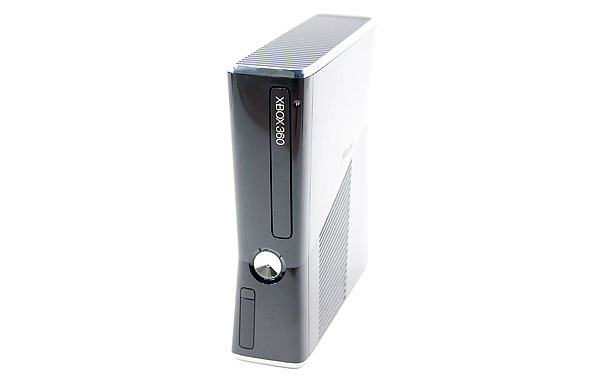
This is the latest revision of the Xbox 360, commonly referred to as the Xbox 360 Slim thanks to its shrinking in virtually all dimensions compared to the previous white box:
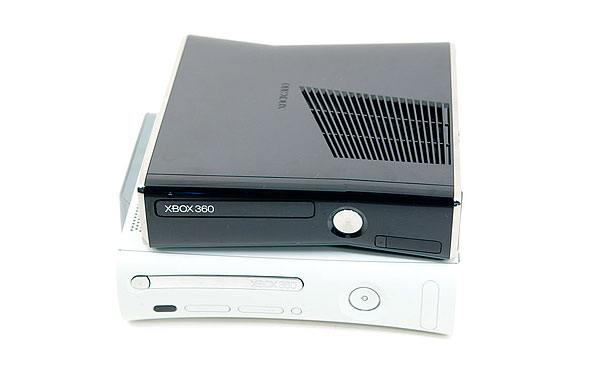

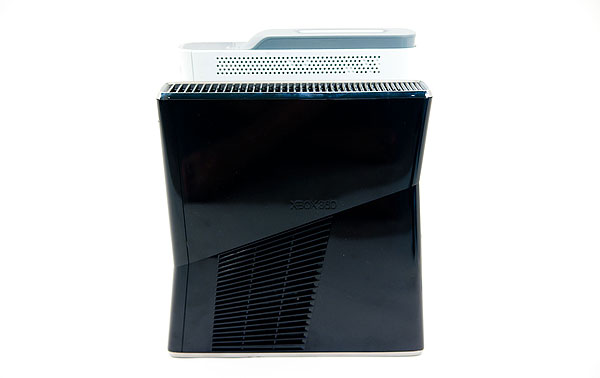
The internals are mostly new, featuring for the first time a single chip with CPU, GPU and eDRAM. Prior to this motherboard revision the Xbox 360 motherboard had two discrete packages, one with the CPU and one with the GPU + eDRAM.
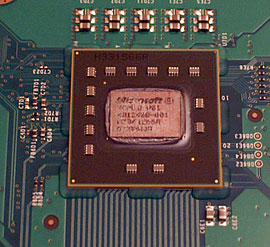 |
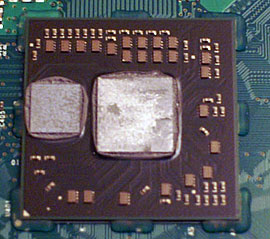 |
For those of you who don't remember, ATI originally designed the Xbox 360's GPU and called it Xenos. The GPU was the first we ever looked at that used a unified shading architecture, so there were no dedicated pixel or vertex units. The core was made up of 48 shader processors and each SP could work on a vect4 plus a scalar op in parallel. These days we'd probably call it a GPU with 240 cores, although it's a bit dated from a functionality standpoint. The GPU runs at 500MHz and is also home to the memory controller.

On a separate die, which ATI referred to as the daughter die, was 10MB of embedded DRAM along with all of the hardware necessary for z and stencil operations, color and alpha processing and AA. This eDRAM and associated logic helped Microsoft bring AA to games and improve overall performance compared to what was possible at the time with conventional architectures.
The CPU, codenamed Xenon, implemented three in-order PowerPC cores with SMT support - meaning the whole chip could work on six threads at the same time. The design was ahead of its time but given its 90nm manufacturing process it only had 1MB of L2 cache to share among all three cores. These days it isn't really considered the ideal approach to a many-core CPU. Private L2 caches with a large shared L3 cache is preferred for scaling beyond two cores.
Leading up to Jasper, each die was shrunk independently with each Xbox iteration. The table below shows us how:
| Xbox 360 Revision | CPU | GPU | eDRAM |
| Xenon/Zephyr | 90nm | 90nm | 90nm |
| Falcon/Opus | 65nm | 80nm | 80nm |
| Jasper | 65nm | 65nm | 80nm |
With the new Xbox 360 (codenamed Valhalla), at least two, possibly all three of the die are combined and placed on a single package:

Bringing it all onto (presumably) a single die makes cooling much simpler as now there’s only one heatsink and one fan for all of the major heat generating components in the unit. This level of integration is made possible only by the not-so-magic of Moore’s Law. At 40nm it shouldn’t be a problem to bring all of those components onto a single reasonably sized die, which in turn reduces Microsoft’s manufacturing costs. It’s not totally clear whether Microsoft is building these chips on a 40nm, 45nm or 55nm node. The 40nm approach would make the most sense but TSMC is very capacity constrained at this point so it would be a slow ramp before all Xboxes got the Valhalla treatment. Update: Apparently 45nm is the magic number. The new CGPU is rumored to be made at Chartered Semiconductor, now under the ownership of Global Foundries.
The uncertainty is because of a pesky heat spreader. While previous Xbox 360 CPU/GPUs were visible to the naked eye once you popped the heatsink off, the Valhalla design has a heat spreader covering the Xbox CGPU (Microsoft’s term, not mine). Unwilling to potentially kill yet another Xbox 360, I’ve left my heat spreader intact for the purposes of this article.
What follows is an entire dissection guide for those of you who want to get inside the new Xbox 360 (for whatever reason you might have ;), as well as some power/noise information for those of you contemplating the upgrade.
Enjoy.










109 Comments
View All Comments
HellcatM - Saturday, June 19, 2010 - link
I guess MS is using different DVD drives because this article says its using a Lite-on, while the one from the link below says it uses a Panasonic. Both are good drives from good companies.http://www.crunchgear.com/2010/06/17/someone-has-a...
Ganesh_balan - Sunday, June 20, 2010 - link
So I happened to read somewhere that although MS says the console cannot RROD it can RDOD and seems like a home user actually faced the wrath. His console was asked to shut down. :DTake that MS!
kratos4u - Tuesday, June 22, 2010 - link
xbox 360s slim = "no RROD" its RDOD (red dot of death ) this time . 299$ worthless . xbox 360 sales high reason pirated games.sorry xbox 360 fanboys
PS3 godz console
bill4 - Wednesday, June 23, 2010 - link
i owned a PS3, it's remarkably poorly engineered. Terrible console, terrible controller, terrible games, terrible graphics. Even the much vaunted Uncharted actually looks pretty janky.TreDawg - Tuesday, June 22, 2010 - link
Does the new 360 still use a 100mbit ethernet port? I was really hoping for them to make the move to gigabit.TheLaw5 - Thursday, June 24, 2010 - link
There's no real point to having Gig networking on a 360. It all reality, it would just be more expenditures and costs for them to put a Gigabit chip on board. That 2.5inch drive isn't going to be making any impressive read/writes. And 10/100mbps Ethernet does a fine job at HD streaming and for Xbox Live...so you know...Yes, it would be nice, but no need.
But to answer your question, I don't know if it has 1000mbps Ethernet, but I highly doubt it.
tipoo - Sunday, December 5, 2010 - link
Why would you ever need gigabit ethernet in the 360? Streaming 1080p content is still far far away from saturating a 100Mbit connection, and even file transfers would get bottlenecked elsewhere.victor2585222 - Monday, June 28, 2010 - link
Umm I wanna buy this new 360 because my old one broke but if I buy the new 360 I would waste my hard drive 80$ Wifi 100$ and a second pair controllers 60$ and my harddrive has all my games in it losing all my achivamants so should I get this new 360 or buy a regular one? If you chose one plz tell me a reason why?Diddy Dave - Thursday, July 1, 2010 - link
Great piece on taking the new XBox apart.I see you show the wi-fi card being removed, which is great. Have you tried to play on it without the wi-fi card plugged in?
I ask because myself and a number of friends get ill from being near wi-fi, and my current 360 is starting to have problems. As such I'll need to get another 360 before my choices are taken away.
thanks.
lazzydragon - Saturday, July 3, 2010 - link
I can't find anything about the scratching of the disks. Both of our xboxes, the original, and the 360 elite, have scratched up a few disks each. We do not turn it on it's side, and we don't move the xbox while it is being played. This usually happens within an hour of playing a new game. (HATE paying over 100$ for one game!!!) I was wondering if this was fixed in the new version. I saw that in the old version, a lot of people had to mod their' own. This is our deciding factor in whether we buy an xbox slim or not. All of our other concerns seem to have been addressed. Thankyou!!!Monica